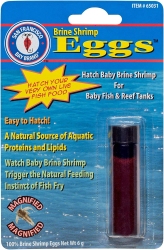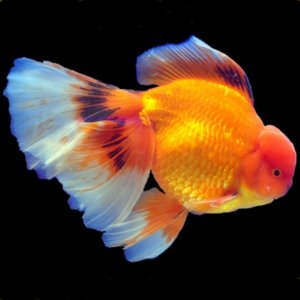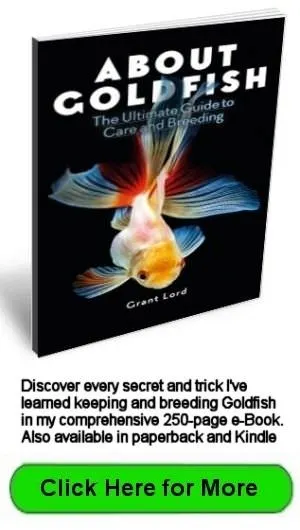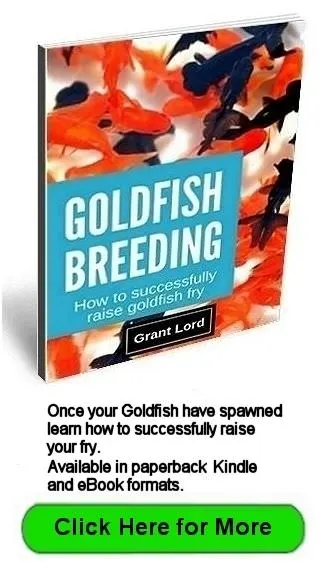- Home
- Raising Goldfish Fry (babies)
- Brine Shrimp
Brine Shrimp
As a first food for goldfish fry, newly hatched brine shrimp are hard to beat.
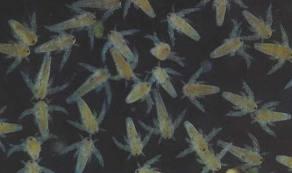 Newly hatched brine shrimp (nauplii)
Newly hatched brine shrimp (nauplii)What Are Brine Shrimp?
Artemia or brine shrimp are aquatic crustaceans that are found worldwide in inland saltwater lakes. Artemia have an ability to live in water with very high salinity, far higher than can be tolerated by fish.
When conditions are not ideal, Artemia produce dormant eggs called cysts. These cysts can be stored for long periods of time, (some say up to 25 years), and hatched when required. This makes them an ideal live food source for any fry capable of eating them, which goldfish fry are.
Advantages and Disadvantages
The advantages of using Artemia are:
- A suitable first food for goldfish fry
- Availability is constant
- Easily able to adjust the quantity hatched to the numbers required
- Disease free
- Easy to hatch and harvest
- Quick hatching time frame (24-36 hours)
- Live for several hours in fresh water
- Cheap to make a hatchery.
Disadvantages:
- A hatchery needs to be constructed or purchased
- Heating to 80oF (26-28oC) is required
- Relatively expensive to purchase.
As you can see, the advantages far outweigh the disadvantages. By far the most important advantage is that fry can eat the shrimp nauplii immediately as their first meal. Trying to produce large quantities of infusoria at the right time is difficult, and foods such as hard boiled egg yolk or liquid fry food tend to pollute the water quickly.
Tip:
If fry don’t get their first meal soon after they are ready for it, their growth will be stunted. They never recover from this. A few of the first fry hatched will eat whatever is available in the hatching container and leave nothing for the rest.
The fry can eat nauplii for several weeks, long enough for you to start culling them down to manageable numbers and introducing them to other foods such as mosquito wrigglers and high quality dry foods.
Seeding The Hatchery
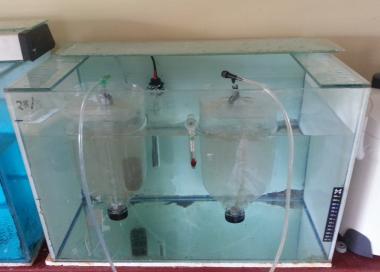 Brine shrimp hatchery utilizing two fruit juice containers
Brine shrimp hatchery utilizing two fruit juice containersI use a two container system because the hatching time for Artemia nauplii is 18-36 hours. By using two containers I can extend the hatching time out to 36 hours and maximize my hatch rate.
(To learn how to make a hatchery go to the brine shrimp hatchery page)
Add some shrimp cysts to container number one. You won’t need many nauplii for the first few days. A half teaspoon of cysts will produce about 280,000 nauplii, so you don’t need many cysts for 2-3000 fry. Fry that have just become free swimming will need about 10-15 nauplii over 2-3 feeds per day for the first few days.
Turn on the air supply and make sure the cysts are not settling at the bottom of the container. They should all be suspended in the water column.
Some hatching instructions tell you to let the cysts hydrate for an hour in fresh water before adding the salt.
This may be the ideal way to maximize the hatch rate, but I reuse the salt water for several days as I usually don't have time to wait around for an hour. After harvesting the last of the nauplii at the afternoon feeding, I sieve the water through a cloth to remove the hatched cyst shells and return the water to the hatchery ready for the next morning when I re-seed it.
This method doesn't seem to affect the nauplii hatching rate adversely that I have noticed.
Tip:
Make the bubbles used to aerate the cysts fairly large because if the bubbles are too small, they tend to froth the water causing the cysts to be deposited up the sides of the hatchery where they won't hatch.
Check that the water temperature is 80oF (26-28oC).
Harvesting the Nauplii
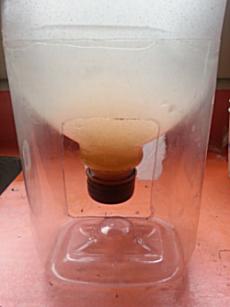 Brine shrimp ready for harvesting
Brine shrimp ready for harvesting24 hours later turn the air supply off to container number one. After about 10 minutes you will find the hatched cyst shells will float to the surface, and an orange-pink cloud of nauplii will sink to the bottom of the container.
Siphon off the nauplii using air line into fine cloth and feed them to your fry. Don’t worry about the small amount of salty water that will find its way into the fry aquarium, it will do more good than harm.
Don’t take all the nauplii as you will need some for the midday and evening feeds. The last of the cysts will hatch during the next 12 hours.
Your fry will develop pink bellies as they fill up with nauplii. The nauplii will remain alive for some time in the fry aquarium. They tend to swim towards light.
After a few hours the nauplii will fall to the bottom, and the fry will show no more interest in them.
You will now have a good idea of how many cysts you need to put into container number two for tomorrow’s feeds.
Tip:
Ideally, you should seed the hatchery in the morning so you have nauplii available throughout the day for your fry.
I use San Francisco Bay Brand brine shrimp eggs because they consistently give excellent hatch rates but you may have to use what you can get.
The eggs are sold in various sizes, but the 6 gram vial pictured is big enough to get you started. You can always buy a bigger amount the next time. Commercial hatcheries buy eggs by the pound!
Hatch-able decapsulated eggs that have had the hard shell stripped off them are also available. The advantage of these eggs is you avoid having to separate the empty shells from the hatched nauplii. Fry tend to swallow the shells if they are introduced into their aquarium during feeding.
Don't buy the freeze dried brine shrimp or non-hatching decapsulated eggs. Non-hatching decapsulated eggs are a possible standby if you realize your brine shrimp won't be hatched by the time your fry are free swimming and looking for their first meal.
You should only need to hatch the nauplii for two or three weeks before moving the fry on to something more substantial such as daphnia.
